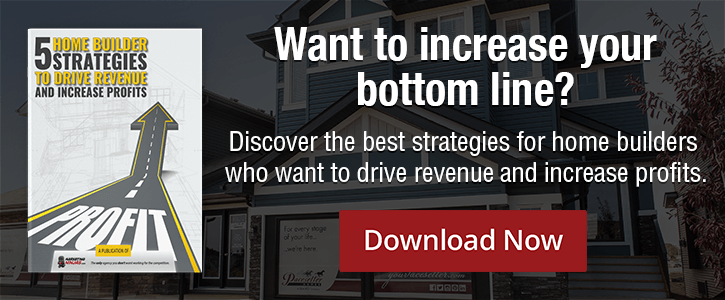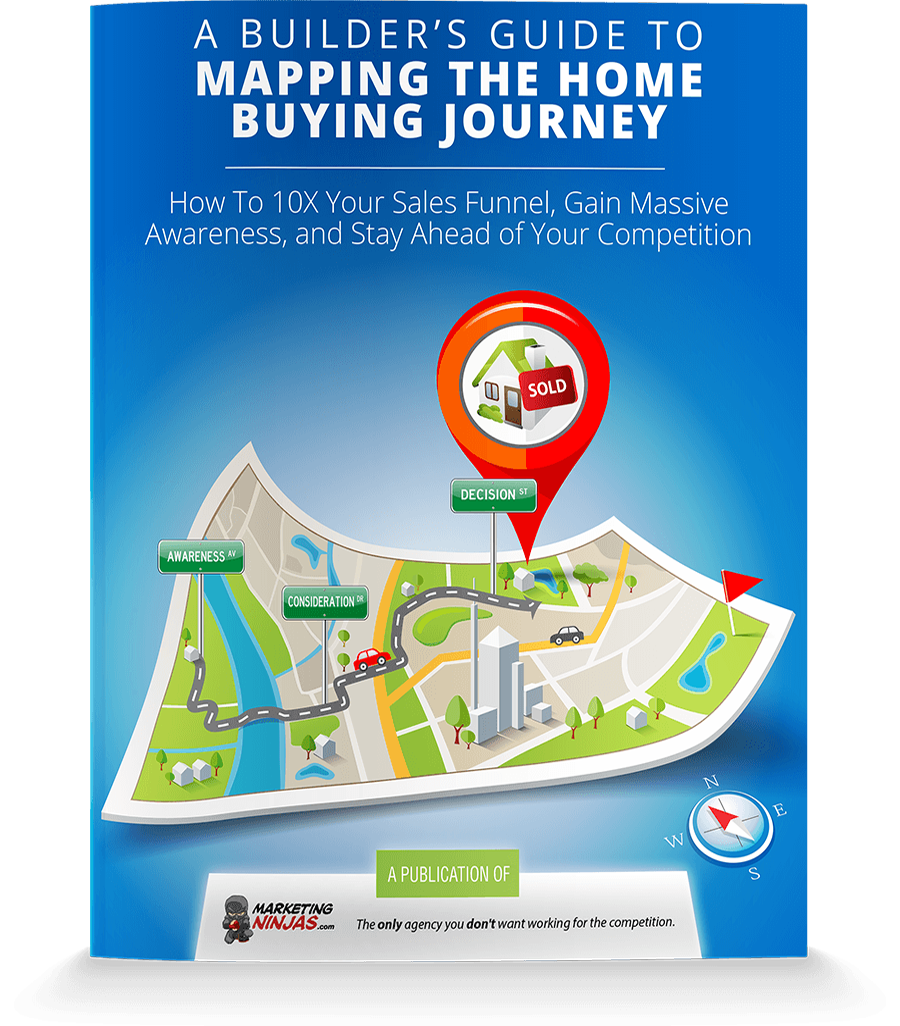Make Them Buy Faster: How to Shorten Your New Home Sales Cycle
For you, the bottom line is the bottom line. Driving revenue is what it all comes down to. Your income comes from selling homes, and unfortunately, sometimes it’s a waiting game.
The frustration of watching lead after lead fade away without converting is undeniable. When we nurture an opportunity, it’s in our nature to want to reap the rewards from it. Patience is, as they say, a virtue; but in the world of business, time is money.
To increase your bottom line faster, you need to shorten your new home sales cycle.
Reading time: 8 minutes
Level: Novice
Skip to the section you're most interested in:
There are a hundred and one ways to pitch a sale, and tactics will often be unique to the individual. Where we can see commonalities, though, is in buyers. When we learn more about frequently faced objections to sales pitches of any kind, we can arm ourselves with the tools to respond to them effectively.
Getting prospective home buyers to make the purchase is one thing, but getting them to do so in a shorter amount of time is a feat that actually requires a lot of behind-the-scenes work beforehand.
Curious to know how it’s done? As you read on, you may want to start drafting an email to your sales manager and your marketing manager – this is a team effort.
They've Got Questions... and Objections
If you’re familiar with content marketing then you know the power of using online content to answer questions posed by prospects. These questions change as prospects travel their home buyer’s journey, moving through stages of Awareness, Consideration, and Decision.
That being said, you’re also aware – and your sales team is definitely aware – it’s not only questions prospects are going to have. They’re also going to have objections.
Objections are the major “roadblocks” your team will face when trying to lead a prospect further down the path to homeownership. Let’s look at some common ones and explore appropriate responses.
Objection 1: Not Ready
“We’re just looking right now”
Some prospects will be in the very, very early stages of the home buying journey and want to avoid hearing your sales pitch by asserting this in every response. Recognize these prospects are in the Awareness stage or perhaps not even quite there yet. You don't want to be a pushy salesperson in your interactions with them, but rather, acknowledge you understand they're just starting out.
Ask them very basic questions like what type of home they’re most interested in. You can attempt to open the lines of communication by offering to email them some blog posts on subjects like “new versus resale homes” or “finding the right home type for your lifestyle.” These types of tactics will help your sales reps stay front-of-mind with these prospects AND it gives them a reason to ask them for their email address and keep in touch.
“We’re not in a position to work with a sales rep yet”
They may then object to being contacted since they’re not yet ready to work with you. A response like, “I completely understand. There is a lot to know about buying a new home and people often have a lot of questions. We have an incredible blog full of helpful information and we send out a newsletter every couple weeks that contains links to these blog posts, and some fun stuff, too! These resources can help answer a lot of questions. Could I sign you up for it? You can unsubscribe at any time if you don't find it valuable.” This a great way to keep these prospects engaged should they change their minds.
 Objection 2: Money
Objection 2: Money
“This is what we want in a home, but it’s outside of our budget”
Money-related objections are probably the most common of them all. The majority of people see money as the main concern, especially when it comes to a large investment like a home. Reassure them your job is to help them find a beautiful home that works for them and is within their budget.
Since these prospects have an idea of what they want in a new home, they’re likely in the Consideration stage, and you can get a little more specific. Ask them what types of features they like. Ask them about their recreational activities and what their lifestyle is like. Then offer to send them links to downloadable sheets showing your standard specifications, and another with upgrade options. Responding “this is a huge benefit of buying new, you can pick and choose which features are most important to you. Would you be interested in my assistance to alter plans to suit your budget?” can spark a working relationship with these prospects.
“It’s cheaper for us to rent”
First-time buyers may throw this one at you. Try to relate and then get them thinking about their future. You might say: “I get where you’re coming from. It may be cheaper to rent, but buying a home means you’re paying your own mortgage instead of your landlord’s. This allows you to build equity and increase your financial position. I have some helpful information about the pros and cons of renting vs buying. Could I send it to you?”
This is a prime example of how salespeople can take advantage of the well-written, source-filled content available at their disposal. It gives prospects something tangible to look at while they deliberate further.
 Objection 3: Time
Objection 3: Time
“We have to sell our current house first”
This type of objection presents us with another opportunity for content. After a salesperson hears this repeatedly, they can consult with the marketing team to create a piece of content like “How to Buy a Home Before Selling Your Old One.”
That way, salespeople can rely not only on their dialogue and existing sales tactics, but they have something valuable to offer prospects. This positions them as a more knowledgeable and trustworthy source. A response like "Ah yes. This is a common scenario that a lot of our customers find themselves in. We've written some really helpful articles about how the home purchase process works when this is your situation. Can I send you some links to those articles?"
“We can’t wait for a new home to be constructed”
If you find a prospect in this scenario, you should dig deeper into what their timeframe for moving in is, and if there's a specific reason why they can't wait. Maybe a quick possession home is a better option for them?
If it's simply because they don't WANT to wait, then content covering the typical timeframe of new home builds or reasons why a new home build is worth waiting for can be helpful. A great response might be: "A lot of new home shoppers feel the same way. Unless you have circumstances requiring you to move immediately, there are actually some amazing benefits to waiting for your new home to be built. I have a couple of great articles explaining those benefits. Could I send them to you?"
If their circumstance is that they CAN'T wait, then say something such as: “I completely understand. Have you considered move-in ready homes as an option?" then set them up with an online showcase of your available quick possession homes that meet their requirements and offer to help them narrow down their search.
Offering to send them content is essentially asking their permission to market to them (which, of course, you want!). And, again, if your prospect has something they can refer back to after they leave your sales office, they may feel less pressure and more inclined to follow-up with you for more information whenever they need it.
It's Still a Process
It may feel like it goes against the grain to offer your prospects content and giving them time to digest it (we understand, you want to get that contract signed as soon as you can!), but think about how you’re setting yourself up for future interactions. For one, you can obtain their contact information in order to send them the promised content, which opens the lines of communication to continue well after they've left your sales office.
Additionally, it allows prospects to privately weigh their options online, on their own terms, which makes them feel empowered instead of pressured. Positioning yourself this way actually gives you more influence over their future buying decisions because you're seen as being helpful and more as a consultant, less as a pushy salesperson.
Lastly, having online resources available to your prospects can help drive more qualified leads to your showhomes because they'll have already done their research and be more sure about their needs.
This is the other huge aspect of this strategy. You want to nurture prospects into more agreeable leads before they even come to you. This means creating content that targets their objections and pain points.
Consider how you might work to overcome objections – before you even have to hear them – by running targeted online marketing campaigns.
Start Campaigning
When you think campaign, you may think of a political campaign. Each tactic employed fits into a larger plan, in the pursuit of one goal. Your online marketing campaigns will work in the same way. With the goal of overcoming one particular objection, there's an entire process and various elements to incorporate into your plan of action.
Generally, a campaign should include:
- A blog post or other piece of content that can circulate
- A premium piece of content or offer that can be downloaded
- A call-to-action for the reader to download said content
- A landing page featuring a form (to download the aforementioned content)
- Social media posts promoting the campaign’s content
Once you have these elements, you can roll out your campaign in steps:
- Planning: Identify your campaign audience, and set your goals and benchmarks.
- Creating: Put together your offers, landing pages, blog posts, and brainstorm some ideas for follow-up campaigns. Make sure everything is SEO optimized with long tail keywords.
- Implementing: Promote your content through social media posts and consider other options to circulate your content, like paid search and other channels.
- Reviewing: Finally, always measure your results! Track sources to see where traffic comes from, and record metrics like views and conversion rate percentages. And make sure to track how many customers came as a result of the campaign. Review customer activity timelines to identify trends and gain an even better idea of what objections seem to be most prevalent in your market. When you know what works, rinse and repeat and look for improvements.
Your marketing team will run these campaigns, but it will be your sales team that applies it in a practical way to the leads that are generated. There's a high degree of integration here. Your sales team will need to be aware of campaign efforts and the content must be made available to them. Conversely, your marketing team needs to know the common objections your sales team is encountering in order to create more relevant and valuable content. Thus, to most effectively make use of your campaigns, it is absolutely crucial your marketing team and sales team work together.
Now that's smarketing!
If you really want to keep your campaigns on track, check out our inbound marketing campaign checklist.
Stay One Step Ahead
The truth is, prospects are always going to have objections. A prospect interacting with a salesperson can have a rebuttal for every option presented. These are impediments that can lengthen your sales cycles and mess with your profit margins. The key, then, is to try and overcome these objections beforehand so the final interactions leading to a sale will not cost as much time and energy.
Don’t sit idly waiting for the payout. Engage both your sales and marketing departments in a collaborative way that utilizes content to boost your revenue – and fast!








